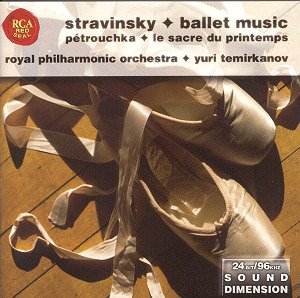 Composer: Igor Stravinsky
Composer: Igor Stravinsky
Works: Pétrouchka (1919 version), Le Sacre du Printemps
Performers: Royal Philharmonic Orchestra, Yuri Temirkanov (conductor)
Recording: 1988, venue not given
Label: RCA RED SEAL 74321 68020 2 DDD [71:17]
Igor Stravinsky’s contributions to the ballet repertoire stand as monumental achievements in 20th-century music, with “Pétrouchka” and “Le Sacre du Printemps” at the forefront of his groundbreaking oeuvre. Both works encapsulate a distinctive blend of rhythmic complexity and innovative orchestration, which transformed the landscape of classical music. “Pétrouchka,” derived from a Russian folk tale, offers a vivid tableau of characters and emotions, while “Le Sacre du Printemps” evokes primal energy and ritualistic fervor. Recorded in 1988 under the baton of Yuri Temirkanov, this disc presents an opportunity to revisit these iconic scores, though the results elicit a mixed response.
Temirkanov’s interpretation of “Le Sacre du Printemps” reveals a conductor who, while technically proficient, often remains within the bounds of convention, lacking the visceral intensity that characterizes the most compelling performances of this work. The opening “Augurs of Spring” fails to elicit the necessary weight; the orchestra’s sound, while competent, pales in comparison to more audacious interpretations, such as Valery Gergiev’s with the Kirov Orchestra. The Royal Philharmonic Orchestra’s playing exhibits a certain restraint that diminishes the work’s inherent ferocity. Notably, the bass drums, which should reverberate with earth-shattering power, merely thud along, lacking the visceral impact that should send shivers down the spine.
In terms of orchestral color, Temirkanov’s reading of “Pétrouchka” similarly suffers from a lack of vibrancy. The bustling atmosphere of “The Shrove-tide Fair” does not quite capture the vivacity inherent in its marking. The string tone, particularly in the opening, is disappointingly recessed, which detracts from the liveliness essential to this scene. The Russian Dance improves slightly, yet it still lacks the zest and finesse seen in performances by other conductors. One cannot help but compare this recording to Stravinsky’s own version with the Columbia Symphony Orchestra, which, despite its historical context, delivers a thrilling experience that highlights the composer’s innovative spirit.
The recording quality itself, while adequate, does not elevate the orchestral performance. There is a lack of dynamic range that hinders the full expression of Stravinsky’s intricate scoring. The balance between sections is uneven, with the winds often struggling to cut through the strings, creating an unbalanced sound that could benefit from a more robust engineering approach.
As a budget introduction to Stravinsky’s ballet music, this disc may serve those new to the composer, but it ultimately lacks the interpretive depth and sonic splendor that seasoned listeners seek. For those already familiar with these masterpieces, there are far more compelling recordings available that capture the wild energy and nuanced character of Stravinsky’s music. Temirkanov’s efforts, though earnest, do not resonate with the transformative power that defines the best interpretations of “Pétrouchka” and “Le Sacre du Printemps.” The performances, though technically sound, fall short of the extraordinary, leaving one yearning for the excitement that these works can truly offer.



